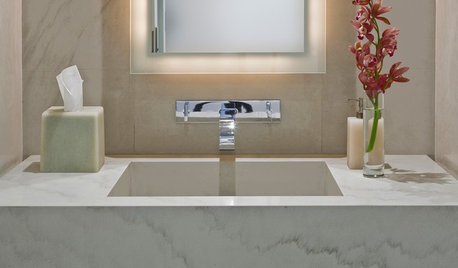water treatment
seanc_bb
13 years ago
Related Stories

BATHROOM DESIGNGreen and Clean: Sleek Water-Wise Bathroom Fixtures
By choosing ecofriendly faucets, showerheads and even toilets, you can save loads of water and money without sacrificing style
Full Story
HEALTHY HOMEHow to Choose a Home Water Filtering System
Learn which water purification method is best for your house, from pitchers to whole-house setups
Full Story
GREEN BUILDINGJust Add Water: Rain Barrel Magic
Take your rainwater storage from practical to beautiful with a new breed of design-friendly rain barrels
Full Story
LANDSCAPE DESIGNHow to Design Your Landscape to Slow Down Water
Putting the brakes on stormwater runoff is the first step in sustainable water design
Full Story
LANDSCAPE DESIGNGet Along With Less Lawn — Ideas to Save Water and Effort
Ditch the mower and lower your water bill while creating a feast for the eyes with diverse plantings and gathering places
Full Story
HOUSEKEEPINGHow to Remove Water Rings From Wood Tables
You may be surprised by some of these ideas for removing cloudy white water marks from wood surfaces
Full Story
LIFEThe Top 5 Ways to Save Water at Home
Get on the fast track to preserving a valuable resource and saving money too with these smart, effective strategies
Full Story
GREEN BUILDINGWater Sense for Big Savings
Keep dollars in your pocket and preserve a precious resource with these easy DIY strategies
Full Story
ARCHITECTUREWant to Live by the Water? What You Need to Know
Waterside homes can have amazing charm, but you'll have to weather design restrictions, codes and surveys
Full Story
KITCHEN DESIGNKitchen of the Week: Elegant Farmhouse Style on the Water
Beautifully designed cabinets and more lend a timeless appeal to this kitchen overlooking a river in Canada
Full StoryMore Discussions




User
seanc_bbOriginal Author
Related Professionals
Adelphi Kitchen & Bathroom Remodelers · Allouez Kitchen & Bathroom Remodelers · Glen Carbon Kitchen & Bathroom Remodelers · Hunters Creek Kitchen & Bathroom Remodelers · Lakeside Kitchen & Bathroom Remodelers · Los Alamitos Kitchen & Bathroom Remodelers · Pearl City Kitchen & Bathroom Remodelers · Toms River Kitchen & Bathroom Remodelers · Trenton Kitchen & Bathroom Remodelers · West Palm Beach Kitchen & Bathroom Remodelers · Westchester Kitchen & Bathroom Remodelers · Wilmington Kitchen & Bathroom Remodelers · Lawndale Kitchen & Bathroom Remodelers · Fairmont Kitchen & Bathroom Remodelers · Wilmington Island Kitchen & Bathroom RemodelersUser
User
seanc_bbOriginal Author
User
seanc_bbOriginal Author
User
seanc_bbOriginal Author
User
User
seanc_bbOriginal Author
User
seanc_bbOriginal Author
User
asolo
User
User
seanc_bbOriginal Author
User
User
seanc_bbOriginal Author
merlin2552